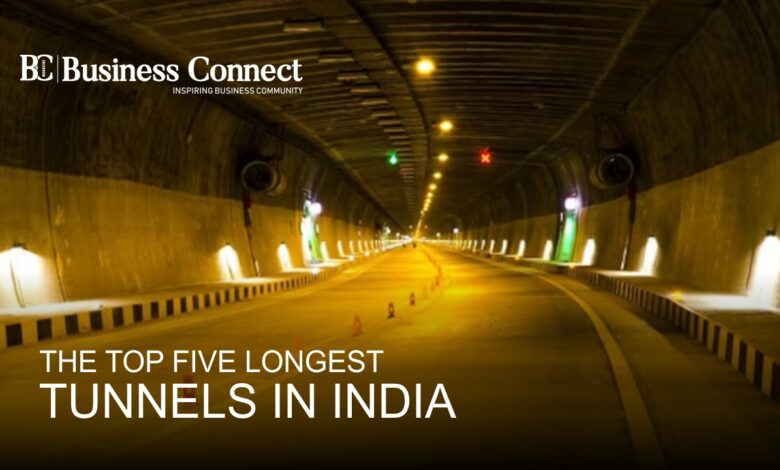Top Five Longest Tunnels In India 2025: Engineering Marvels

India has some impressive longest tunnels. These tunnels improve transportation and connectivity. They are built through mountains and other difficult landscapes which have made travelling faster and safer. These tunnels play a decisive and crucial role in reducing travel time. It connects remote areas and contribute to the development of infrastructure of the nation.
In this blog, we will discuss the top five longest tunnels in India 2025. These tunnels are listed below-
-
Pir Panjal Railway Tunnel
- Location- Pir Panjal Range of middle Himalayas in Jammu and Kashmir, India
- Constructed by- Ircon International Ltd. Under the Ministry of Railways
- First trial run- 28th December 2012
- Official inauguration- 26th June 2013 by former Prime Minister Dr. Manmohan Singh
- Length: 21 km (6.97 mi).
- Track Gauge: 1,676 mm (5 ft 6 in) (Broad Gauge).
- Elevation: 1,760 m (5,770 ft) above sea level.
- Width: 40 metres (27.6 ft).
- Height: 39 metres (24.2 ft).
- Operating Speed: Up to 75 km/h (47 mph).
- Number of Tracks: Single track.
The Pir Panjal Railway Tunnel is the longest transportation tunnel of India. It connects Kashmir valley with the Jammu region. It is a part of Jammu- Baramulla railway line. This tunnel provides a railway connection between Banihal (located in Jammu) and Qazigund (located in Kashmir valley).
It is operated by the Indian Railways. The tunnel was opened for commercial operations on 27th June 2013. It provides an alternative route to Jawahar Tunnel which frequently gets blocked due to snow in winters. This tunnel is the first ever railway link between Jammu and Kashmir which provides all weather transport connectivity for the Kashmir Valley.
-
Syama Prasad Mukherjee Tunnel
- Location: Jammu and Kashmir, India
- Route: National Highway 44 (NH 44)
- Crosses: Patnitop, Kud, and Batote
- Start Point: Chenani
- End Point: Nashri, Ramban District
- Length: 28 km (5.77 mi)
- Number of Lanes: 2
- Width: 13 m (43 ft)
- Highest Elevation: 1,200 m (3,937 ft)
- Operating Speed: 50 km/h
- Owner: National Highways Authority of India (NHAI)
- Design Engineer: IL&FS Transportation Networks Ltd
- Construction Start Date: July 2011
- Inauguration Date: 2 April 2017
- Construction Cost: ₹3,720 crore (US$430 million)
- Traffic Type: Automotive (except fuel tankers)
This tunnel is popularly known as Chennai- Nashri Tunnel. It is one of the longest road tunnels of India, stretching 9.28 kilometres. It connects Chenani to Nashri of Jammu and Kashmir. It is an all weather and bidirectional tunnel which bypasses through the treacherous Patnitop route. It was inaugurated by the Prime Minister of India, Narendra Modi on 2nd April 2017.
This tunnel is equipped with advanced safety system. It has a parallel escape tunnel which allows safe evacuation in case of any emergency. It monitors real time traffic movement, air quality and security. This tunnel can automatically detect over speeding and wrong lane driving. It has surveillance cameras placed over every 75 meters beautiful. It adopts innovative ventilation system which ensures clean air by removing exhaust gases and dust particles.
- Atal tunnel
- Location – Himachal Pradesh, India
- Constructed by- Border Roads Organisation (BRO)
- First trial run- September 2020
- Official inauguration- 3rd October, 2020 by Prime Minister Narendra Modi
- Length: 02 km (5.6 mi)
- Shape: Horseshoe cross-section
- Width: 10 meters (33 feet)
- Altitude: 3,000–3,100 meters (9,840–10,170 feet)
- Speed Limit: 40–60 km/h (25–37 mph)
- Excavation Method: Drill & Blast with New Austrian Tunnelling Method (NATM)
- Ventilation System: Semi-transverse system with large fans for fresh air circulation
- Emergency Tunnel: A 2.25m high and 3.6m wide passage beneath the main carriageway.
The idea of construction of this tunnel was first discussed in 1860 by the Moravian Mission. Later on, it was conceived in 1942 by Dr. John Bicknell. It is a 9.02 kilometres road tunnel. It connects Manali and Keylong in Himachal Pradesh. It is situated in eastern Pir Panjal Range of Himalayas.
This tunnel bypasses the Rohtang Pass. It is named in the honour of former Prime Minister Atal Bihari Vajpayee. It has semi transverse system with large fans for fresh air circulation. This tunnel provides year round connectivity to the remote Lahaul- Spiti valley. It provides improved access to Ladakh for both military and civilian purposes.
-
Thiruvananthapuram Port Tunnel
It is located in Kerela. It aims to enhance connectivity to Trivandrum Port. It has a length of 9 kilometres. This road tunnel was inaugurated in 2022. It facilitates smooth transportation of goods. This project was designed to provide smooth and efficient route for heavy vehicles. It is fully equipped modern engineering tools which ensures safety and durability for users. It has advanced lighting systems, ventilation mechanism and advanced safety systems for emergency.
-
Banihal- Qazigund Road Tunnel
- Location: Jammu and Kashmir, India
- Route: National Highway 44 (NH 44)
- Start Point: Qazigund
- End Point: Banihal
- Length:45 km (5.25 mi)
- Elevation: 1,790 m (5,870 ft)
- Number of Lanes: 4 (Two lanes per tube in a twin-tube structure)
- Tunnel Width: 7 m (23 ft) per tube
- Operating Speed: 70 km/h (43 mph)
- Owner & Operator: National Highways Authority of India (NHAI)
- Construction Started: 2011
- Opened for Traffic: 4 August 2021
- Construction Cost: ₹2,100 crore
- Toll Plaza: Qazigund Toll Plaza
Structural Features & Safety Measures
- Twin-Tube Design: Two separate tunnels for each direction of traffic
- Interconnecting Passages: Every 500 m (1,600 ft) for emergency evacuation.
It is an important highway tunnel in Jammu and Kashmir, India. It is located below the Banihal Pass in the Pir Panjal Mountain range. It is a part of National Highway 44. It provides an all weather connectivity link between Jammu and Srinagar.
It has a length of 8.45 km. National Highways Authority of India (NHAI) is the owner and operator of this tunnel. It has two separate tunnels for each direction of traffic. It is equipped with interconnecting passages, ventilation system. It has 126 jet fans for air circulation. It has 234 cctv cameras for real time monitoring.






